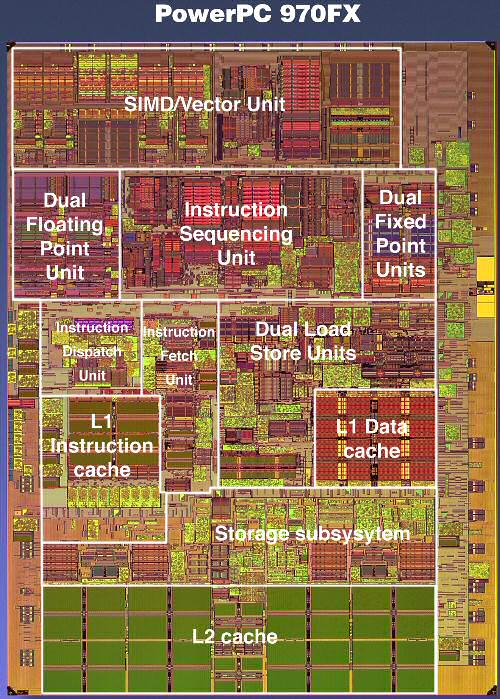No more mysteries: Apple's G5 versus x86, Mac OS X versus Linux
by Johan De Gelas on June 3, 2005 7:48 AM EST- Posted in
- Mac
IBM PowerPC 970FX: Superscalar monster
Meet the G5 processor, which is in fact IBM's PowerPC 970FX processor. The RISC ISA, which is quite complex and can hardly be called "Reduced" (The R of RISC), provides 32 architectural registers. Architectural registers are the registers that are visible to the programmer, mostly the compiler programmer. These are the registers that can be used to program the calculations in the binary (and assembler) code.
The 970FX is deeply pipelined, quite a bit deeper than the Athlon 64 or Opteron. While the Opteron has a 12 stage pipeline for integer calculations, the 970FX goes deeper and ends up with 16 stages. Floating point is handled through 21 stages, and the Opteron only needs 17. 21 stages might make you think that the 970FX is close to a Pentium 4 Northwood, but you should remember that the Pentium 4 also had 8 stages in front of the trace cache. The 20 stages were counted from the trace cache. So, the Pentium 4 has to do less work in those 20 stages than what the 970FX performs in those 16 or 21 stages. When it comes to branch prediction penalties, the 970FX penalty will be closer to the Pentium 4 (Northwood). But when it comes to frequency headroom, the 970FX should do - in theory - better than the Opteron, but does not come close to the "old" Pentium 4.

The 970FX works out of order and up to 200 instructions can be kept in flight, compared to 126 in the Pentium 4. The rate at which instructions are fetched will not limit the issue rate either. The PowerPC 970 FX fetches up to 8 instructions per cycle from the L1 and can decode at the same rate of 8 instructions per cycle. So, is the 970FX the ultimate out-of-order CPU?
While 200 instructions in flight are impressive, there is a catch. If there was no limitation except die size, CPUs would probably keep thousands of instructions in flight. However, the scheduler has to be able to pick out independent instructions (instructions that do not rely on the outcome of a previous one) out of those buffers. And searching and analysing the buffers takes time, and time is very limited at clock speeds of 2.5 GHz and more. Although it is true that the bigger the buffers, the better, the number of instructions that can be tracked and analysed per clock cycle is very limited. The buffer in front of the execution units is about 100 instructions big, still respectable compared to the Athlon 64's reorder buffer of 72 instructions, divided into 24 groups of 3 instructions.
The same grouping also happens on the 970FX or G5. But the grouping is a little coarser here, with 5 instructions in one group. This grouping makes reordering and tracking a little easier than when the scheduler would have to deal with 100 separate instructions.
The grouping is, at the same time, one of the biggest disadvantages. Yes, the Itanium also works with groups, but there the compilers should help the CPU with getting the slots filled. In the 970FX, the group must be assembled with pretty strict limitations, such as at one branch per group. Many other restrictions apply, but that is outside the scope of this article. Suffice it to say that it happens quite a lot that a few of the operations in the group consist of NOOP, no-operation, or useless "do nothing" instructions. Or that a group cannot be issued because some of the resources that one member of the group needs is not available ( registers, execution slots). You could say that the whole grouping thing makes the Superscalar monster less flexible.
Branch prediction is done by two different methods each with a gigantic 16K entry history table. A third "selector" keeps another 16K history to see which of the two methods has done the best job so far. Branch prediction seems to be a prime concern for the IBM designers.
Memory Subsystem
The caches are relatively small compared to the x86 competition. A 64 KB I-cache and 32 KB D-cache is relatively "normal", while the 512 KB L2-cache is a little small by today's standards. But, no complaints here. A real complaint can be lodged against the latency to the memory. Apple's own webpage talks about 135 ns access time to the RAM. Now, compare this to the 60 ns access time that the Opteron needs to access the RAM, and about 100-115 ns in the case of the Pentium 4 (with 875 chipset).A quick test with LM bench 2.04 confirms this:
| Host | OS | Mem read (MB/s) | Mem write (MB/s) | L2-cache latency (ns) | RAM Random Access (ns) |
| Xeon 3.06 GHz | Linux 2.4 | 1937 | 990 | 59.940 | 152.7 |
| G5 2.7 GHz | Darwin 8.1 | 2799 | 1575 | 49.190 | 303.4 |
| Xeon 3.6 GHz | Linux 2.6 | 3881 | 1669 | 78.380 | 153.4 |
| Opteron 850 | Linux 2.6 | 1920 | 1468 | 50.530 | 133.2 |
Memory latency is definitely a problem on the G5.
On the flipside of the coin is the excellent FSB bandwidth. The G5/Power PC 970FX 2.7 GHz has a 1.35 GHz FSB (Full Duplex), capable of sending 10.8 GB/s in each direction. Of course, the (half duplex) dual channel DDR400 bus can only use 6.4 GB/s at most. Still, all this bandwidth can be put to good use with up to 8 data prefetch streams.










116 Comments
View All Comments
Rosyna - Friday, June 3, 2005 - link
Actually, for better or worse the GCC Apple includes is being used for most Mac OS X software. OS X itself was compiled with it.elvisizer - Friday, June 3, 2005 - link
rosyna's right.i'm just not sure if there IS anyway to do the kind of comparison you seem to've been shooting for (pure competition between the chips with as little else affecting the outcome as possible). you could use the 'special' compilers on each platform, but those aren't used for compiling most of the binaries you buy at compusa.
elvisizer - Friday, June 3, 2005 - link
why didn't you run some tests with YD linux on the g5?!?!?!?!?!?!? you could've answered the questions you posed yourself!!!!!argh.
and you definitly should've included after effects. "we don't have access to that software" what the heck is THAT about?? you can get your hands on a dual 3.6 xeon machine, a dual 2.5 gr, and adual 2.7 g5, and you can't buy a freaking piece of adobe software at retail?!?!?!?!?!
some seroiusly weird decisions being made here.
other than that, the article was ok. re-confirmed suspicions i've had for awhile about OS X server handling large numbers of thread. My OS X servers ALWAYS tank hard with lots of open sessions, so i keep them around only for emergencies. They are so very easy to admin, tho, they're still attractive to me for small workgroup sizes. like last month, I had to support 8 people working on a daily magazine being published at e3. litterally inside the convention center. os x server was perfect in that situation.
Rosyna - Friday, June 3, 2005 - link
There appears to be either a typo or a horrible flaw in the test. It says you used GCC 3.3.3 but OS X comes with gcc version 3.3 20030304 (Apple Computer, Inc. build 1809).If you did use GCC 3.3.3 then you were giving the PPC a severe disadvantage as the stock GCC has almost no optimizations for PPC while it has many for x86.
Eug - Friday, June 3, 2005 - link
"But do you really think that Oracle would migrate to this if it wasn't on a par?"[Eug dons computer geek wannabe hat]
There are lots of reasons to migrate, and I'm sure absolute performance isn't always the primary concern. We won't know the real performance until we actually see tests on Oracle/Sybase.
My uneducated guess is that they won't be anywhere near as bad as the artifical server benches might suggest, but OTOH, I could easily see Linux on G5 significantly besting OS X on G5 for this type of stuff.
ie. The most interesting test I'd like to see is Oracle on the G5, with both OS X and Linux, compared to Xeon and Opteron with Linux.
And yeah, it would be interesting to see what gcc 4 brings to the table, since 3.3 provides no autovectorization at all. It would also be interesting to see how xlc/xlf does, although that doesn't provide autovectorization either. Where are the autovectorizing IBM compilers that were supposed to come out???
melgross - Friday, June 3, 2005 - link
As none of us has actual experiance with this, none of us can say yes or no.But do you really think that Oracle would migrate to this if it wasn't on a par? After all Ellison isn't on Apple's board anymore, so there's nothing to prove there.
I also remember that going back to Apple's G4 XServes, their performance was better than the x86 crowd, and the Sun servers as well. Those tests were on several sites. Been a while though.
JohanAnandtech - Friday, June 3, 2005 - link
querymc: Yes, you are right. The --noaltivec flag and the comment that altivec was enabled by default in the gcc 3.3.3 compiler docs made me believe there is autovectorization (or at least "scalarisation"). As I wrote in the article we used -O2 and and then tried a bucket load of other options like --fast-math --mtune=G5 and others I don't remember anymore but it didn't make any big difference.querymc - Friday, June 3, 2005 - link
The SSE support would probably also be improved by using GCC 4 with autovectorization, I should note. There's a reason it does poorly in GCC 3. :)querymc - Friday, June 3, 2005 - link
Johan: I didn't see this the first time through, but you need to make a slight clarification to the floating point stuff. There is no autovectorization capability in GCC 3.3. None. There is limited support for SSE, but that is not quite the same, as SSE isn't SIMD to the extent that AltiVec is. If you want to use the AltiVec unit in otherwise unaltered benchmarks, you don't have a choice other than GCC 4 (and you need to pass a special flag to turn it on).Also, what compiler flags did you pass on each platform? For example, did you use --fast-math?
JohanAnandtech - Friday, June 3, 2005 - link
Melgross: Apple told me that most xserves in europe are sold as "do it all". A little webserver (apache), a database sybase, samba and so on. They didn't have any client who had heavy traffic on the webserver, so nobody complains.Sybase/oracle seems to have done quite a bit of work to get good performance out of Mac OS-x, so it must be interesting to see how they managed to solve those problems. But I am sceptical that Oracle/Sybase runs faster on Mac OS x than on Linux.